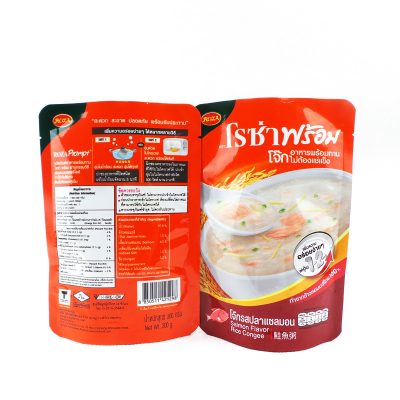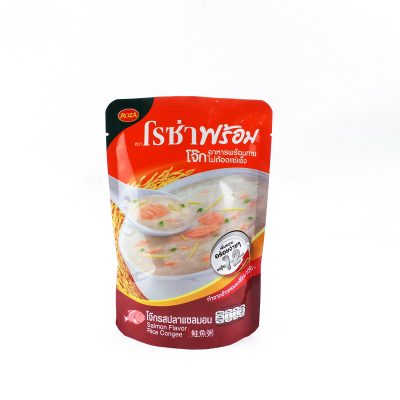The manufacturing process of heat-resistant cooking bags At present, most of the cooking bags in the world are manufactured by dry compounding method, and a few of them can also be manufactured by solvent-free compounding method or co-extrusion compounding method. The quality of dry compounding is higher than that of solvent-free compounding, and the arrangement and combination of materials are more reasonable and wider than that of co-extrusion compounding, and the use is more assured. In our country, 100% of the cooking bags are currently manufactured by dry compounding method, so only the dry compounding manufacturing process will be discussed here.
The first is the selection of materials. According to the end use of the cooking bag to determine which substrates to use, how to combine, which ink and adhesive to use. The so-called end use refers to what kind of food the bag is to be packed and what is the weight of the packaging. After packaging, how high temperature (121℃, 128 packs) should be withstood, so that the packaging bag has a reasonable cost performance, so it is important to understand the end use. The second is to determine the process parameters. After determining the base material and auxiliary materials , You can place an order to the workshop for production. As the technical management and operation personnel of the workshop production, you must strictly follow the requirements of the process sheet to the department and prepare the materials. Don’t make a mistake.
Then, in the specific operation, the process parameters of the process sheet should be followed, including the number of lines and dot depth of the glue roller, the concentration of the operating glue, the temperature of each heating section of the drying tunnel, and the size of the exhaust air volume of the blast quantum port. , Start-up speed, as well as the control of unwinding tension, drying tunnel tension, winding tension, surface temperature and composite pressure of the composite steel roller, etc. Among the above process parameters, the amount of glue required (usually 4~5g/m2) and the amount of residual solvent required (the national standard is less than 10mg/m2, and the internal control of the enterprise is preferably less than 3mg/m2). The key to quality must be taken seriously.
Third: During the specific compounding operation, some adhesive suppliers require that the second layer (PET/AL or OPA/AL) be reconstituted for the first time? Put it in the curing room at 50~55℃. After 4h or 12h, perform the second third layer (PET/AL/CPP or PET/AL/OPA) compounding. This process is required every time the compounding is completed, but there are also many adhesive punishments that can be done in one go. After the first, third, and even fourth floors are all restored, they are then placed in the maturation room at 50~55℃ to let them mature. The latter adhesive is more beneficial to production management and labor productivity. The fourth is maturation. Regarding the maturation temperature and maturation time, it is generally required to keep it at 50~55℃ for more than 48h, preferably 72h, but some adhesives require 15~7 days. This point must be done in accordance with the requirements of the product specifications of various crystal brand models, and the curing temperature is too low and the curing time is too short. The temperature in the maturation room should be maintained until all points are the same by means of ventilation and flow. The indoor air should also be replaced appropriately, and the residual solvent released during maturation should be exhausted to the outdoors to supplement with clean and fresh fresh air. Reduce the amount of residual solvent and ignorance of the compound, which is beneficial to improve the quality of the product. The fifth is to detect bag making. After the composite is cured, the composite fastness between the layers and the amount of residual solvent must be tested first, and the data can be taken out to make the bag after the data meets the requirements. Composite film is used to make empty retort bags. Most of them are made into flat bags or self-supporting bags with three-side sealing, and rarely made into the shape of middle seam (back seal) bags. The heat sealing strength of composite films with different structures, different combinations and different layers is different, which can be between 45~80N/15mm. For composite films with different structure combinations and different layers, the process parameters of heat-sealing bags should also be different. The process parameters of heat-sealing bag making are mainly temperature, pressure and time. They are mutually complementary and dependent on each other. Among them, temperature plays a leading role, and pressure and time play an auxiliary role. We know that retort bags use CPP film or HDPE film as the heat-sealable layer. Their melting point is higher than that of LDPE, so the temperature of the hot knife is much higher than that of LDPE film, mostly between 180 and 230 ℃. If the temperature is too low, no matter how high the pressure is, no matter how long the pressure is, the CPP cannot be melted and self-adhesive. Only by selecting a suitable temperature, and after a certain contact pressure and contact time, can the heat sealing be completed. The purpose of the bag. When heat-sealing the bag, the composite with fewer composite layers and thinner thickness, the lower the temperature of the hot knife. The more layers, the thicker the composite film, or the composite film that also contains aluminum foil, the temperature of the hot knife should be Higher. From the longitudinal distribution of the hot knives on the bag making machine, there are generally two or three rows, and there are several in each row. The temperature must be the same for every hand and every point of every hand, otherwise, the sealing strength of the bag will be inconsistent, some are high, some are low. We must strictly control and frequently observe and inspect. When heat-sealing the bag, the pressure of the hot knife can neither be too small nor too large. Too small, insufficient fastness, too large, and may damage the original thickness of the CPP or HDPE inner film, making the total thickness of the two-layer inner film of the heat-sealed welding part smaller than the original sum of the two layers, resulting in The sealing force is reduced. What needs to be reminded is that when the hot knife is pressed down, you must not rely on the inner side of the bag with high pressure and the outer side with low pressure. It is best to adjust the pressure on the inner side of the bag to be slightly smaller, so that when the two inner membranes are welded under pressure, the thickness on the inner side will be reduced and the original shape of the film will be damaged, so that the sealing strength can be guaranteed. For different composite membranes, it is best to use a heat seal tester to detect the best three parameters of temperature, time and pressure, and then use them as the basis for workshop operations. With a little adjustment, you can make a good The bag is out. In order to make the finished bag not only firm, but also smooth and beautiful, after the heat sealing, it should be cooled and shaped with a cold knife while maintaining a certain tension to avoid wrinkles and ripples. The so-called cold knife is a hollow copper square tube cooled by tap water.
When in use, be sure to let cold tap water flow in, and the warm and hot water after heat exchange flow out to keep the knife at a lower temperature. If there is no circulating tap water for heat exchange, the water temperature in the pipe will be different after a long time. As it rises, the cooling effect is not good. Therefore, the operator should pay attention to the inspection, don’t forget to use cooling water, and don’t let the pipe block up. 2. Product standards and project testing of high-temperature cooking bags. The product standard for high-temperature cooking bags in China was the earliest GB10004-1988 “Polyester (PET) Aluminum Foil (AL) Polypropylene (CPP) Composite Film Bag”, which is the standard; The material structure only has three layers of PE/AL/CPP, and the cooking conditions are limited to 121℃·40min. It was revised ten years later and changed to G810004-1998 “Retort-resistant composite film and bag”. The material structure of the product has been expanded to include PET/CPP, PA/CPP two-layer transparent type and PET/AL/CPP, PA /AL/CPP three-layer opaque type, PET/PA/CPP three-layer transparent type, and PET/AL/PA/CPP four-layer opaque type. In terms of the physical and mechanical properties of the product, the three project indicators of medium resistance, peeling force after cooking and heat sealing strength after cooking have been increased, and the original oil resistance project has been cancelled, highlighting the product’s high temperature resistance and practicality. sex. After being revised again in 2002, the heat-resistant retort bags were included in the “General Rules for Packaging Composite Films and Bags”. This latest standard was approved in Guiyang at the end of December 2002, and the draft for approval was formally confirmed. Text, but has not yet been promulgated and implemented.




















